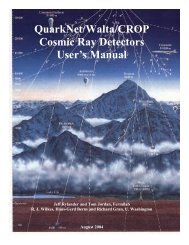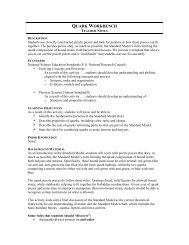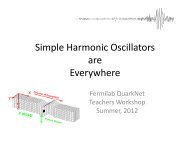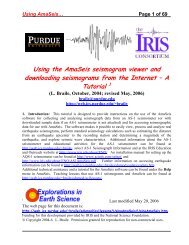Teaching Modern Physics - QuarkNet - Fermilab
Teaching Modern Physics - QuarkNet - Fermilab
Teaching Modern Physics - QuarkNet - Fermilab
Create successful ePaper yourself
Turn your PDF publications into a flip-book with our unique Google optimized e-Paper software.
However, to do it the “normal way,” one uses:<br />
F = m v 2 /r = q v B → p = q r B<br />
p = (1.6 × 10 -19 C) (0.25 m) (2 T) = 0.8 × 10 -19 kg m/s<br />
Converting to “particle physics momentum”:<br />
pparticle = pnormal × [3 × 10 8 m/s] / [1.6 × 10 -19 J/eV] =<br />
1. 5 × 10 8 eV/c = 0.15 GeV/c<br />
An alternate approach is to use:<br />
p = q r B = pparticle physics × [q/c] → pparticle physics = c r B<br />
(which will give a momentum in units of eV/c.)<br />
To make the more useful GeV/c, multiply by the conversion for GeV/eV (10 -9 ).<br />
This gives a nice and final result:<br />
pparticle physics = 0.3 r B<br />
where r is in meters, B is in Tesla<br />
and pparticle physics is in GeV/c.<br />
4. The <strong>Fermilab</strong> accelerator is designed to accelerate protons in a circular orbit with radius 1<br />
km and to a momentum p. The new LHC accelerator accelerates protons to a momentum<br />
seven times that of the <strong>Fermilab</strong> accelerator. If the radius of circular motion followed by<br />
a proton in the LHC is 4.3 km, calculate the ratio of the magnetic field of the Tevatron to<br />
the LHC.<br />
F = m v 2 /r = q v B → p = q r B → B = p/(q r)<br />
Thus,<br />
BLHC/BTevatron = [p/(q r)]LHC / [p/(q r)]Tevatron = [pLHC / pTevatron] [rTevatron / rLHC]<br />
BLHC = [7/1] [1/4.3] = 1.63 BTevatron<br />
20








